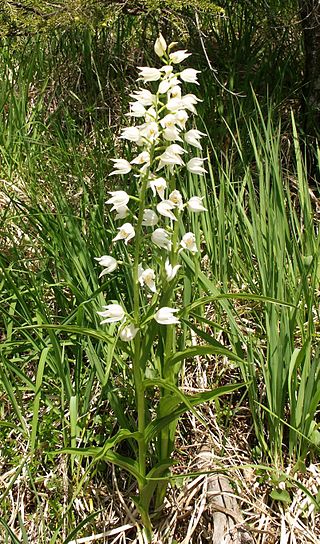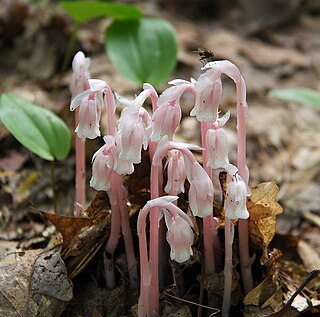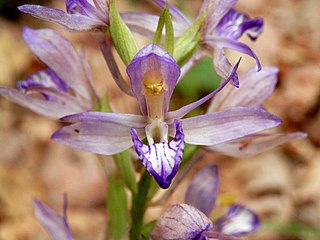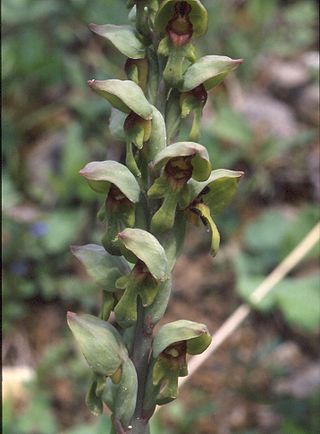
Orchids are plants that belong to the family Orchidaceae, a diverse and widespread group of flowering plants with blooms that are often colourful and fragrant.

Anacamptis is a genus of flowering plants in the orchid family (Orchidaceae); it is often abbreviated as Ant in horticulture. This genus was established by Louis Claude Richard in 1817; the type species is the pyramidal orchid and it nowadays contains about one-third of the species placed in the "wastebin genus" Orchis before this was split up at the end of the 20th century, among them many that are of hybrid origin. The genus' scientific name is derived from the Greek word anakamptein, meaning "to bend backwards".

The Russulaceae are a diverse family of fungi in the order Russulales, with roughly 1,900 known species and a worldwide distribution. They comprise the brittlegills and the milk-caps, well-known mushroom-forming fungi that include some edible species. These gilled mushrooms are characterised by the brittle flesh of their fruitbodies.

Orchis is a genus in the orchid family (Orchidaceae), occurring mainly in Europe and Northwest Africa, and ranging as far as Tibet, Mongolia, and Xinjiang. The name is from the Ancient Greek ὄρχις orchis, meaning "testicle", from the appearance of the paired subterranean tuberoids.

Lepanthes is a large genus of orchids with about 800–1000 species, distributed in the Antilles and from Mexico through Bolivia. The genus is abbreviated in horticultural trade as Lths. Almost all the species in the genus are small and live in cloud forests. Babyboot orchid is a common name.

Galeola is a genus of orchids belonging to the subfamily Vanilloideae.

Neottia nidus-avis, the bird's-nest orchid, is a non-photosynthetic orchid, native to Europe, Russia, with sporadic presence in North-Africa, and some parts of the Middle East.

Cephalanthera, abbreviated Ceph in horticultural trade, is a genus of mostly terrestrial orchids. Members of this genus have rhizomes rather than tubers. About 15 species are currently recognized, most of them native to Europe and Asia. The only species found in the wild in North America is Cephalanthera austiniae, the phantom orchid or snow orchid. Ecologically, this species is partially myco-heterotrophic. Some of the Eurasian species hybridise.

Myco-heterotrophy is a symbiotic relationship between certain kinds of plants and fungi, in which the plant gets all or part of its food from parasitism upon fungi rather than from photosynthesis. A myco-heterotroph is the parasitic plant partner in this relationship. Myco-heterotrophy is considered a kind of cheating relationship and myco-heterotrophs are sometimes informally referred to as "mycorrhizal cheaters". This relationship is sometimes referred to as mycotrophy, though this term is also used for plants that engage in mutualistic mycorrhizal relationships.

A parasitic plant is a plant that derives some or all of its nutritional requirements from another living plant. They make up about 1% of angiosperms and are found in almost every biome. All parasitic plants develop a specialized organ called the haustorium, which penetrates the host plant, connecting them to the host vasculature – either the xylem, phloem, or both. For example, plants like Striga or Rhinanthus connect only to the xylem, via xylem bridges (xylem-feeding). Alternately, plants like Cuscuta and some members of Orobanche connect to both the xylem and phloem of the host. This provides them with the ability to extract resources from the host. These resources can include water, nitrogen, carbon and/or sugars Parasitic plants are classified depending on the location where the parasitic plant latches onto the host, the amount of nutrients it requires, and their photosynthetic capability. Some parasitic plants can locate their host plants by detecting volatile chemicals in the air or soil given off by host shoots or roots, respectively. About 4,500 species of parasitic plants in approximately 20 families of flowering plants are known.

Wullschlaegelia is a genus of orchids,, consisting of two species in the Caribbean Islands and to much of Latin America from southern Mexico to northern Argentina. These are myco-heterotrophic plants, lacking chlorophyll and subsisting entirely on nutrients obtained from soil fungi. The genus has previously been included in the tribe Calypsoeae, but is now included as the only genus in the tribe Wullschlaegelieae, pending further study.
Stereosandra is a genus of leafless orchids native to Southeast Asia, the range extending north to Yunnan, Taiwan and the Ryukyu Islands, and also eastward to New Guinea, the Solomon Islands and Samoa. These are myco-heterotrophic orchids, lacking chlorophyll, obtaining nutrients from fungi in the soil instead.

Limodorum abortivum, also known as Violet Limodore or Violet bird's-nest orchid, is a species of myco-heterotrophic, achlorophyllous orchid and is native to mainland Europe, western Asia and the Mediterranean area.

Russula brevipes is a species of mushroom commonly known as the short-stemmed russula or the stubby brittlegill. It is widespread in North America, and was reported from Pakistan in 2006. The fungus grows in a mycorrhizal association with trees from several genera, including fir, spruce, Douglas-fir, and hemlock. Fruit bodies are white and large, with convex to funnel-shaped caps measuring 7–30 cm (3–12 in) wide set atop a thick stipe up to 8 cm (3 in) long. The gills on the cap underside are closely spaced and sometimes have a faint bluish tint. Spores are roughly spherical, and have a network-like surface dotted with warts.

Neotinea is a genus of flowering plants from the orchid family, Orchidaceae. It is native to much of Europe, the Mediterranean region, and the islands of the eastern Atlantic, from the Canaries, Madeira and Ireland east to Iran and Western Siberia.

Steveniella is a genus of flowering plants from the orchid family, Orchidaceae. Only one species is known, Steveniella satyrioides, native to Iran, Turkey, Crimea and the Caucasus.

Corsia is a little-studied plant genus from the monocotyledon family Corsiaceae. It was first described in 1877 by Italian naturalist Odoardo Beccari and contains 25 species, all of which lack chlorophyll and parasitize fungi for nutrition. All 25 species are distributed through New Guinea, the Bismarck Archipelago, the Solomon Islands and Queensland, Australia.

Neottieae is an orchid tribe in the subfamily Epidendroideae. It contains six genera and over 200 species distributed mainly in temperate and subtropical zones of the northern hemisphere. All its members are terrestrial plants, hinting at an early branching with Epidendroideae which is largely an epiphytic group. Neottieae is likely to be the result of a single temperate radiation of epidendroids, although it appears that some lineages in this tribe have crept back into the tropics.
Vietorchis is a genus of myco-heterotrophic flowering plants in the orchid family, Orchidaceae. It contains only one known species, Vietorchis aurea, endemic to northern Vietnam.

Phalaenopsis difformis, also known as the dark brown Phalaenopsis, is a species of epiphytic orchid native to Assam, Borneo, China South-Central, China Southeast, East Himalaya, Laos, Malaya, Myanmar, Bangladesh, Nepal, Sumatera, Thailand, Vietnam and West Himalaya.


















